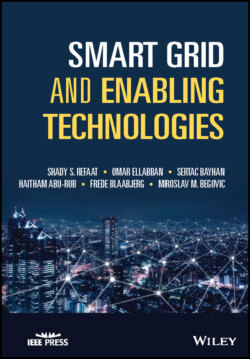Читать книгу Smart Grid and Enabling Technologies - Frede Blaabjerg - Страница 81
2.5 Conclusion
ОглавлениеAfter the explanation of the different RES, it should be considered that each source of renewable energy has its ups and downs as summarized by Table 2.3. Moreover, Table 2.4 illustrates some undesirable environmental effects of RES [9].
Figure 2.34 Modern power system flexibility measures.
Figure 2.35 Overview of technical solutions for renewables integration into SG [63].
As a result of a shortage of inexhaustible resources, and environmental issues due to emissions, conventional energy production predicated upon fossil fuels are considered to be unsustainable in the long term. Therefore, numerous works are invested globally for integration of more renewable energies. RES are advanced options for electrical power generation and their chance to meet the world's energy need. This chapter presents an up‐to‐date and detailed current status and future projection of major renewable energy resources, and their benefits, growth, investment and implementation. To sum up, the deployment of renewable energy is one of the essential elements for a better reliability and resilience of the actual power grid. Moreover, the implementation of RES into SG system will aid in meeting the electrical power demands effectively.
Table 2.3 Advantages and disadvantages of different renewable energy resources. Ref Num [9]. Reproduced with permission from ELSEVIER
| Energy source | Advantages | Disadvantages |
|---|---|---|
| Bioenergy Energy | Abundant and renewableCan be used to burn waste products | Burning biomass can result in air pollutionMay not be cost effective |
| Geothermal Energy | Provides an unlimited supply of energyProduces no air or water pollution | Start‐up/development costs can be expensiveMaintenance costs, due to corrosion, can be a problem |
| Hydropower Energy | Abundant, clean, and safeEasily stored in reservoirsRelatively inexpensive way to produce electricityOffers recreational benefits like boating, fishing, etc. | Can cause the flooding of surrounding communities and landscapesDams have major ecological impacts on local hydrology. Can have a significant environmental impactCan be used only where there is a water supplyBest sites for dams have already been developed |
| Marine Energy | Ideal for an island countryCaptures energy that would otherwise not be collected | Construction can be costlyOpposed by some environmental groups as having a negative impact on wildlifeTakes up lots of space and difficult for shipping to move around |
| Solar Energy | Potentially infinite energy supplyCauses no air or water pollution | May not be cost effectiveStorage and backup are necessaryReliability depends on availability of sunlight |
| Wind Energy | Is a free source of energyProduces no water or air pollutionWind farms are relatively inexpensive to buildLand around wind farms can have other uses | Requires constant and significant amounts of windWind farms require significant amounts of landCan have a significant visual impact on landscapesNeed better ways to store energy |
Table 2.4 Some negative environmental impacts of different renewable energy resources. Ref Num [9]. Reproduced with permission from ELSEVIER
| Energy source | Potential negative impacts on the environment |
|---|---|
| Bioenergy Energy | May not be CO2 natural, may release global warming gases like methane during the production of biofuels, landscape change, deterioration of soil productivity, hazardous waste. |
| Geothermal Energy | Subsidence, landscape change, polluting waterways, air emissions |
| Hydropower | Change in local eco‐systems, change in weather conditions, social and cultural impacts |
| Marine Energy | Landscape change, reduction in water motion or circulation, killing of fish by blades, changes in sea eco‐system |
| Solar Energy | Soil erosion, landscape change, hazardous waste |
| Wind Energy | Noises in the area, landscape change, soil erosion, killing of birds by blades |
